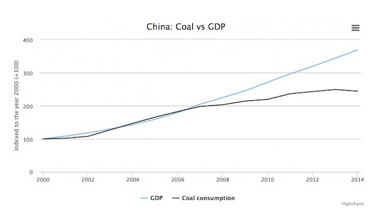by Rona Fried
I’m seeing signs that efforts to reduce carbon emissions are beginning to work and that the link between economic growth and energy consumption is breaking.
Let’s take a look at China, the UK and US as examples of this trend.
Coal Use Drops in China!
Last year, coal consumption fell for the first time in China – by 2.9% from 2013, according to Chinese government data. Domestic coal production fell 2.5%, and that means emissions are coming down.
There couldn’t be much bigger news than this, since China has been the main source of growing world emissions for years.
It’s not that energy consumption is going down – it rose 2.2% last year and the economy grew 7.4%.

Even though China used 5.9% more oil in 2014, that’s still well below the 7.4% GDP growth rate. Wind capacity grew 26%, solar 67%, and nuclear 36%.
The government has promised that coal use will peak in 2020 and energy-related emissions in 2030, but if this trend continues, China could reach these goals earlier.
China also has goals of low-carbon energy supplying 15% of total energy by 2020 and 20% by 2030.
Indeed, instead of building another coal plant every week, as has been the case for 20 years, they will build the equivalent of carbon-free power every week for the coming decades, says Joe Romm at ThinkProgress.
"That means adding some 800-1000 gigawatts of zero-carbon power in the next 16 years, which is "more than all the coal-fired power plants that exist in China today and close to total current electricity generation capacity in the US," he explains.
Similar Situation in US, UK
In the US, GDP grew 3.9% in the third quarter of 2014 – the strongest growth in over a decade – but oil consumption fell 0.3%. This year, oil demand is expected to rise 0.7%, but the economy will grow four times faster.
The UK did better. In the fourth quarter, GDP grew 2.6% while energy consumption dropped 7%, according to the Department of Energy & Climate Change. Efficiency has been improving 3% a year since 2000, they say.
Renewable energy and nuclear supplied 36%, gas 30% and coal 33.6%, down from 40.6% in 2013.
Meanwhile, the UK held its first renewable energy auction this week and awarded contracts for 2 gigawatts (GW) of projects, enough to power 1.4 million homes. Projects include five solar farms, 15 onshore wind farms and a 714 MW offshore wind farm.
Separately, the UK approved the world’s largest offshore wind farm by far. The 2.4 GW project will rival the country’s largest power plants, supplying energy to 2.5% of citizens. Dogger Bank Creyke Beck will be 80 miles from shore, the furthest offshore than any before and occupying about 430 square miles.
Energy efficiency and wind energy are replacing gas and coal, according to Eurostat, which compiles official statistics.
The UK is firmly on track to get 15% of all energy from renewables by 2020 (30% of electricity) and could well decarbonize its power system within 15 years. And the EU as a whole will get 20% of all energy from renewables by 2020.
Read our article, Climate Battle Is Shifting, Finally Scaling to the Problem.

